My prof explains how we shouldn't be like for our presentations.
Friday, November 30, 2012
Thursday, November 29, 2012
Making a schedule
You don't realise how little time you have until you start to make a calendar of all the things you need to do and when I did that.. well that's how it feels.
Thursday, November 22, 2012
Tricycle features and links
This is just a collection of research on certain interesting features on tricycle wheelchairs seen on youtube and etc. A lot of which has influenced and fueled inspiration for the project. Enjoy.
TRICYCLES
Leveraged Freedom Chair v1, lever powered wheelchair on tarmac and off road:
http://gogrit.org/lfc/
Whirlwind Rough Rider, $799
http://whirlwindwheelchair.squarespace.com/roughrider/
Kien Tuong Tricycle Wheelchair, Three wheel foldable tricycle:
http://www.kientuong.net/Pages/3Wheeloutdoorchair.aspx
Motivation tricycle, 135 GBP, hand powered and good for long distances:
http://www.motivation.org.uk/our-products/tricycles/
Three Wheeled outdoor / spike chair, 12kg, pigging, for sports:
http://www.handinor.no/index.php/3-hjuls-piggestol
Mountaintrike, Small radius, adjustable:
http://www.flo-design.nl/mountaintrike.html
Free Wheelchair Mission Gen 1, simple construction, $71.88:
http://www.freewheelchairmission.org
Free Wheelchair Mission Gen 2, adjustable:
https://vimeo.com/fwm
Hand bike ride, Adaptive Cycling, Tricycle for paraplegic wheelchair user:
http://youtu.be/Uth_n8QZxZ0
TEAM HYBRID HANDCYCLES, Hand cycle:
http://youtu.be/xNYMe3DeTfI
FEATURES
Fietsen met benen en armen (1942) Hand propulsion system:
http://youtu.be/QRS5rKhNHSk
Assistive Technologies OBOW II, open sourced, modular:
https://vimeo.com/37032126
Assistive Technologies at maker-faire:
http://youtu.be/e0txmOLieac
DIY Assistive Technologies, one arm drive attachment, $35:
http://youtu.be/fP2gt5bOcBI
DIY Assistive Technologies - Mini Handychair, small turning radius, good for transfer:
http://youtu.be/HinhllYjBOE
DIY Assistive Technologies - Garden Off Road, Wheelchair steering by hand or pole:
http://youtu.be/uZAKbO6iSkc
DIY Assistive Technologies - Beach Handychair, Wheelbarrow-esque:
http://youtu.be/F6W3UIKG7IQ
DIY Assistive Technologies - Wooden Handychair, Outside simple gardening @5:13:
http://youtu.be/D4ou4LIQ3VA
DIY Assistive Technologies - Tracktor, uses two bicycles, @0:30:
http://youtu.be/dT141PxU8eo
Electric bike adaption for wheel chair, turns standard trike into an electric one:
http://youtu.be/JikRgENekuw
Handbike for wheelchair user, Rio Dragonfly:
http://youtu.be/h4I4UUMgsks
Wheelchairs for developing countries:
http://youtu.be/oJMg8J_E4fc
Cargobikes, Mobility for Good:
http://worldbike.org/our-work-two
ACE, The tennis wheelchair for developing countries:
http://youtu.be/nGxh-q_k-j4
Wheelchairs For Kids, $125, donated:
http://www.wheelchairsforkids.org/videos/model09.html
DIY-AT, Wooden Handychair - water bottle upholstery @4:30:
http://youtu.be/fP2gt5bOcBI
Skywheel - Rainbow H, single hand or body steer:
http://www.skywheel.kr/
Da Vinci Handcycle, manual wheelchair attachment:
http://www.davincimobility.com/
Sunrise Runner, attachable to any wheelchair:
http://bit.ly/SZ140h
Rehatri 24, £790.00 pedal back brake:
http://www.missioncycles.co.uk/disabled_cycling.asp
One-Off Handcycle, DC model, made from local parts:
www.oneoffhandcycle.com
The XLT, 15deg camber for stability, and seatbelt.. £1899:
http://www.allabilitycycling.com/handcycles.aspx
Figure 8 drive:
http://web.mit.edu/mbollini/www/tricycle/Concept.html
PEDAL POWER
Spin cycle: pedal powered bicycle machine
http://bit.ly/WnK7lN
“Bicimaquinas” (pedal-powered machines) bicycles into machines:
http://www.mayapedal.org/
Pedal powered farms
http://www.lowtechmagazine.com/2011/05/pedal-powered-farms-and-factories.html
Cycle cinema:
http://www.magnificentrevolution.org/
Seed cleaner
http://bit.ly/XHSIfV
Global cycle solutions, sheller kit:
http://gcstz.com/products
Fully Belly project, nut sheller:
http://www.thefullbellyproject.org/Products/UniversalNutSheller.aspx
Standard bicycle with pedal power attachment:
http://www.technologyforthepoor.com/PedalPowerReport/PedalPowerReport.htm
Make electricity while you exercise:
http://bit.ly/11Zz4mH
DOCUMENTS/ PROJECTS
Provision and Sourcing of Manual Wheelchairs:
http://www.streetsie.com/provision-manual-wheelchairs/
Design with the other 90%:
http://designother90.org/
Nothing About Us, Without Us:
http://www.dinf.ne.jp/doc/english/global/david/dwe001/dwe00141.html
Bicycles and Tricyles, an elementary treatise on their design and construction, 1986:
http://bit.ly/d7LKjG
GhanaMoves project, Sander Projects:
http://ghanamoves.weblog.nl/
http://ghanamoves2007.weblog.nl/
http://www.sanderprojects.com/
TRICYCLES
Leveraged Freedom Chair v1, lever powered wheelchair on tarmac and off road:
http://gogrit.org/lfc/
Whirlwind Rough Rider, $799
http://whirlwindwheelchair.squarespace.com/roughrider/
Kien Tuong Tricycle Wheelchair, Three wheel foldable tricycle:
http://www.kientuong.net/Pages/3Wheeloutdoorchair.aspx
Motivation tricycle, 135 GBP, hand powered and good for long distances:
http://www.motivation.org.uk/our-products/tricycles/
Three Wheeled outdoor / spike chair, 12kg, pigging, for sports:
http://www.handinor.no/index.php/3-hjuls-piggestol
Mountaintrike, Small radius, adjustable:
http://www.flo-design.nl/mountaintrike.html
Free Wheelchair Mission Gen 1, simple construction, $71.88:
http://www.freewheelchairmission.org
Free Wheelchair Mission Gen 2, adjustable:
https://vimeo.com/fwm
Hand bike ride, Adaptive Cycling, Tricycle for paraplegic wheelchair user:
http://youtu.be/Uth_n8QZxZ0
TEAM HYBRID HANDCYCLES, Hand cycle:
http://youtu.be/xNYMe3DeTfI
TRUmobility - Assistive Mobility devices for the disabled:
FEATURES
Fietsen met benen en armen (1942) Hand propulsion system:
http://youtu.be/QRS5rKhNHSk
Assistive Technologies OBOW II, open sourced, modular:
https://vimeo.com/37032126
Assistive Technologies at maker-faire:
http://youtu.be/e0txmOLieac
DIY Assistive Technologies, one arm drive attachment, $35:
http://youtu.be/fP2gt5bOcBI
DIY Assistive Technologies - Mini Handychair, small turning radius, good for transfer:
http://youtu.be/HinhllYjBOE
DIY Assistive Technologies - Garden Off Road, Wheelchair steering by hand or pole:
http://youtu.be/uZAKbO6iSkc
DIY Assistive Technologies - Beach Handychair, Wheelbarrow-esque:
http://youtu.be/F6W3UIKG7IQ
DIY Assistive Technologies - Wooden Handychair, Outside simple gardening @5:13:
http://youtu.be/D4ou4LIQ3VA
DIY Assistive Technologies - Tracktor, uses two bicycles, @0:30:
http://youtu.be/dT141PxU8eo
Electric bike adaption for wheel chair, turns standard trike into an electric one:
http://youtu.be/JikRgENekuw
Handbike for wheelchair user, Rio Dragonfly:
http://youtu.be/h4I4UUMgsks
Wheelchairs for developing countries:
http://youtu.be/oJMg8J_E4fc
Cargobikes, Mobility for Good:
http://worldbike.org/our-work-two
ACE, The tennis wheelchair for developing countries:
http://youtu.be/nGxh-q_k-j4
Wheelchairs For Kids, $125, donated:
http://www.wheelchairsforkids.org/videos/model09.html
DIY-AT, Wooden Handychair - water bottle upholstery @4:30:
http://youtu.be/fP2gt5bOcBI
Skywheel - Rainbow H, single hand or body steer:
http://www.skywheel.kr/
Da Vinci Handcycle, manual wheelchair attachment:
http://www.davincimobility.com/
Sunrise Runner, attachable to any wheelchair:
http://bit.ly/SZ140h
Rehatri 24, £790.00 pedal back brake:
http://www.missioncycles.co.uk/disabled_cycling.asp
One-Off Handcycle, DC model, made from local parts:
www.oneoffhandcycle.com
The XLT, 15deg camber for stability, and seatbelt.. £1899:
http://www.allabilitycycling.com/handcycles.aspx
Figure 8 drive:
http://web.mit.edu/mbollini/www/tricycle/Concept.html
PEDAL POWER
Spin cycle: pedal powered bicycle machine
http://bit.ly/WnK7lN
“Bicimaquinas” (pedal-powered machines) bicycles into machines:
http://www.mayapedal.org/
Pedal powered farms
http://www.lowtechmagazine.com/2011/05/pedal-powered-farms-and-factories.html
Cycle cinema:
http://www.magnificentrevolution.org/
Seed cleaner
http://bit.ly/XHSIfV
Global cycle solutions, sheller kit:
http://gcstz.com/products
Fully Belly project, nut sheller:
http://www.thefullbellyproject.org/Products/UniversalNutSheller.aspx
Standard bicycle with pedal power attachment:
http://www.technologyforthepoor.com/PedalPowerReport/PedalPowerReport.htm
Make electricity while you exercise:
http://bit.ly/11Zz4mH
DOCUMENTS/ PROJECTS
Provision and Sourcing of Manual Wheelchairs:
http://www.streetsie.com/provision-manual-wheelchairs/
Design with the other 90%:
http://designother90.org/
Nothing About Us, Without Us:
http://www.dinf.ne.jp/doc/english/global/david/dwe001/dwe00141.html
Bicycles and Tricyles, an elementary treatise on their design and construction, 1986:
http://bit.ly/d7LKjG
GhanaMoves project, Sander Projects:
http://ghanamoves.weblog.nl/
http://ghanamoves2007.weblog.nl/
http://www.sanderprojects.com/
Wednesday, November 21, 2012
Monday, November 12, 2012
Prototype vs prototype
Our (Team Harambee's) hard work vs (Team) Aaron's hard work:
Neither is perfect, but both have some definite learning points. Alright, aaaaand back to work!
Neither is perfect, but both have some definite learning points. Alright, aaaaand back to work!
Labels:
Graduation project,
process,
Uganda,
update
Friday, November 9, 2012
Day 3: Final advice
We began our day late, but with two boxes of suzyQ donuts. I think donuts are a Canadian culture thing (hem, Tim Hortons) as we were all really excited about it but I wonder if Noel and Aaron got that. Anyway we made a plan for the day and tried our best to stick to it.
Today's takeaway:
1. When communicating, especially when not in person, double check your english.
- Make sure it is clear with simple sentences
- Use point form when you can so items can be easily addressed
- Don't put multiple questions in one sentence
2. When testing protoypes and getting feedback from users...
- Keep in mind that they will point out the obvious before understanding the nuances of the product
- Compare initial perception of product with how long they get to try the product
- Fit and finish (or lack thereof) can be distracting
3. Try to explain what you do in eight words or less
- Look at your general context and narrow it to a focal context
- Link people with processes
- Line up assumptions and list your unknowns
We also took the trikes out for a final joy ride and photos, before taking it apart and packing it back to San Francisco. I was excited to take it apart because when I first saw it I didn't understand what all the parts meant. Now I can see everything in isolation mode. In about an hour we stuffed everything back into the box, taped it together and said adieu. Until next time!




One of our group members took advantage of the short time we had and turned the trike into an impromptu vendor cart trying to sell coffee to passerbys just to get an idea for what it may feel like.
Today's takeaway:
1. When communicating, especially when not in person, double check your english.
- Make sure it is clear with simple sentences
- Use point form when you can so items can be easily addressed
- Don't put multiple questions in one sentence
2. When testing protoypes and getting feedback from users...
- Keep in mind that they will point out the obvious before understanding the nuances of the product
- Compare initial perception of product with how long they get to try the product
- Fit and finish (or lack thereof) can be distracting
3. Try to explain what you do in eight words or less
- Look at your general context and narrow it to a focal context
- Link people with processes
- Line up assumptions and list your unknowns
We also took the trikes out for a final joy ride and photos, before taking it apart and packing it back to San Francisco. I was excited to take it apart because when I first saw it I didn't understand what all the parts meant. Now I can see everything in isolation mode. In about an hour we stuffed everything back into the box, taped it together and said adieu. Until next time!




One of our group members took advantage of the short time we had and turned the trike into an impromptu vendor cart trying to sell coffee to passerbys just to get an idea for what it may feel like.
The past three days have been exhausting but really great. Noel and Aaron are wonderful mentors. They are really great listeners and are open and accepting. I also think that's what makes them good at what they do. Having the two of them together was super. One brought a 'How to design and think in this context' mindset while the other provided a 'this is how it is built and why' angle to the table. The marriage of their expertise from experience was really valuable to our team. It was like a knowledge and support power boost! Many thanks to Noel and Aaron for coming up here to Ottawa!
Labels:
doodle,
Graduation project,
Uganda,
update
Suzy Q's
Sneaking out to get SuzyQ's donuts for our friends and eating some before we gift them. That's 225 calories per donut and a pair of sticky fingers and three boxes of yummy-joy. And! When recounting the tale, he referred to me as a friend! I'm honoured!
Thursday, November 8, 2012
Be brilliant
Today I bumped into an old professor of mine, and as I bade him good night, he gave me a big sweet (and surprising!) hug and said, "Be brilliant!"
Day 2: Meeting our friends from Kasese online
This morning we had an online meeting with some people in Kasese:
Peter – in charge of KADUPEDI
Phestus – Youth coordinator at KADUPEDI
Robert – a friend of Navin
Kio – builds tricycles
Using Skype, we all crammed ourselves into the webcam’s view. “We” consisted of:
The students: Andrew, Alyssa, Ruby, Carmen
The guests: Noel, Aaron
The SID: Bjarki
The READ Institute: Dean, Dale
CanUgan: Navin
This was our first official meeting with them so we were all very excited. We did a short debriefing of who the meeting should generally pan out. Within minutes we were connected and having hello at one another. We introduced ourselves and got to ask them questions relevant to our project focus. I didn’t really prepare properly because I assumed we were sticking to the questions we had emailed them earlier so I had difficulty asking the right questions when it was my turn. I was concerned about trying to ask open ended questions yet still addressing important information that would be relevant to my project rather than asking for validation of a project or an idea. (ie. Should I design this for you, do you / would you like… ) How do you design WITH someone if you just offer them things from a vague idea of something you're not even entirely clear about? All of that was going through my head while trying to think on my feet asking questions at the same time. Finally someone was like, "Just tell them your idea" so I started again and with an understandable example they could give me real feedback I told them about power exchange and tools with the trike in a brief manner and they said they know about it and had wanted to put it into practise, but has never done it (yet). That's a green light! (and wasn't so hard was it)
What I need to learn:
One thing that was interesting to note, however, was a comment from Kio, the manufacturer, who asked us what was wrong with the current tricycle, because in fact, it's 85% improved. We don't want to go there and tell him that his parts are wrong and that we can do better because we know better and therefore he should make our designs instead. That also isn't our goal at all. So there is some rethinking to do to close the gap of miscommunication between us.
At the end of the call, Aaron and Noel gave feedback at the end of the call. I think that's a good habit to pick up. (end of event summary/review) Or perhaps it is easier to provide suggestions as an observer rather than a participant.
Items noted:
In the afternoon we attended a TSES lecture by Aaron Wieler from Whirlwind Wheelchairs about the journey of design and fabrication in the world of wheelchairs (in/for developing countries) while his buddy Noel doodled his way through the lecture on-screen, live.
And that's a wrap! Long day innit?
My team and I have been busy being happy sponges, absorbing as much as we can as quickly as we can. Usually our brains are gone by the end of the day so I can imagine our two new friends from San Francisco must be equally tired if not more. Goodnight!
Peter – in charge of KADUPEDI
Phestus – Youth coordinator at KADUPEDI
Robert – a friend of Navin
Kio – builds tricycles
Using Skype, we all crammed ourselves into the webcam’s view. “We” consisted of:
The students: Andrew, Alyssa, Ruby, Carmen
The guests: Noel, Aaron
The SID: Bjarki
The READ Institute: Dean, Dale
CanUgan: Navin
This was our first official meeting with them so we were all very excited. We did a short debriefing of who the meeting should generally pan out. Within minutes we were connected and having hello at one another. We introduced ourselves and got to ask them questions relevant to our project focus. I didn’t really prepare properly because I assumed we were sticking to the questions we had emailed them earlier so I had difficulty asking the right questions when it was my turn. I was concerned about trying to ask open ended questions yet still addressing important information that would be relevant to my project rather than asking for validation of a project or an idea. (ie. Should I design this for you, do you / would you like… ) How do you design WITH someone if you just offer them things from a vague idea of something you're not even entirely clear about? All of that was going through my head while trying to think on my feet asking questions at the same time. Finally someone was like, "Just tell them your idea" so I started again and with an understandable example they could give me real feedback I told them about power exchange and tools with the trike in a brief manner and they said they know about it and had wanted to put it into practise, but has never done it (yet). That's a green light! (and wasn't so hard was it)
What I need to learn:
- How to frame questions properly
- Use easy examples
- Speaking using non-technical terms (is drivetrain a technical term?)
- Asking to repeat if you can't hear clearly
- How to talk to people who aren't in science or design
- To remember that it's neither we nor them, but us
One thing that was interesting to note, however, was a comment from Kio, the manufacturer, who asked us what was wrong with the current tricycle, because in fact, it's 85% improved. We don't want to go there and tell him that his parts are wrong and that we can do better because we know better and therefore he should make our designs instead. That also isn't our goal at all. So there is some rethinking to do to close the gap of miscommunication between us.
At the end of the call, Aaron and Noel gave feedback at the end of the call. I think that's a good habit to pick up. (end of event summary/review) Or perhaps it is easier to provide suggestions as an observer rather than a participant.
Items noted:
- Should keep building the relationship between students and Kadupedi/Kio - make a call schedule
- Mail things over now - create a physical exchange and see how long it takes to arrive
- It's really important to create a good relationship, this allows for the ease of either party to speak freely and to understand each other's nuances
- Include tricycle riders in the design process and not just the manufacturer
- Consider compensation for expertise
Thumbs up for class.
In the lecture, Aaron shared anecdotes of his previous work and process. In this field, his design framework consists of appropriate technologies, co-creation, participating development, and creative capacity building. One of the key things was to always ask questions and listen.
"Even when you're feeling hot and sweaty and you just want them to tell you they like the wheelchair, you need to ask questions about their mobility needs/solutions vs "Hey, do you like this?". Also, don't be afraid to put yourself out there. Crowdsource! There are lots of answers that can come through that may be really helpful."
His second takeaway point was to always keep your assumptions in check. Don't let your assumptions keep you from asking for real feedback, and lay them out so you can address them without having them secretly dictate your user research and design without knowing.
In the evening, we attended the Peeter Kruus Memorial lecture held by Noel Wilson, from Catapult Design. The topic was 'The Joys and Challenges of Designing with Social Intent'.
Here, Noel took us through his work at Catapult, a "socially motivated" design firm. That means (without being too idealistic) that they try to help people at the bottom of the pyramid thrive through design and at the same time help clients bring their products to market. He gave us a list of tips for overcoming the challenges of designing with social intent. I don't have the complete list, but here's most of it.
- Roleplay - wigs help
- Storify - make good stories
- Break your prototypes - For heaven's sake, it's a prototype!
- Iterate - become intimate with your product
- Co-create - you may not always have an answer but maybe the result is just the relationship
- Iterate.
- Manufacture - know your capacity and limits
- Iterate.
- Pilot - Take it out and give it a run
And that's a wrap! Long day innit?
My team and I have been busy being happy sponges, absorbing as much as we can as quickly as we can. Usually our brains are gone by the end of the day so I can imagine our two new friends from San Francisco must be equally tired if not more. Goodnight!
Labels:
concepts,
doodle,
Graduation project,
Uganda,
update
Wednesday, November 7, 2012
Three day knowledge transfer - Noel Wilson x Aaron Wieler
We have three days with these two guys from San Francisco. There was so much we learned compacted in a single day that when I got home at night I had to write everything down in fear of forgetting it. Report writing / story writing is a good skill I suppose, so perhaps this post will come in handy some day, if not just to jog my memory.
 First, we introduced ourselves, and the project in general, and then each of our individual focus in the project. They then asked us how we came to our project focus --What are our motivations?
First, we introduced ourselves, and the project in general, and then each of our individual focus in the project. They then asked us how we came to our project focus --What are our motivations?
For Andrew, it was innovative opportunities through income generation via the tricycle
For me, it was to increase the bicycle (drivetrain) power to do other things
For Ruby, it was to increase accessible mobility through extended mobility
For Alyssa, it was sustainable development through addressing manufacturing methods and standardisation
Second, they gave us feedback and useful resources to check out.
In terms of "bicycle power":
Third, they addressed the multiple-agenda holders in the project. This was a scary looking list (because it was so long) but it was really good to see what we (as students) need to fulfill and what are the expectations of others. They also pointed out that we needed to be realistic about our time boundaries. (An 8-month project) and that being said, what do we want from it? "You need to be a little selfish" one said as the other nodded in agreement. "One time when I was hired," Noel began, "My manager asked me what I wanted out of the job, and I gave her my answer. Good, was her response, I don't like to keep/hire people who don't know why they're here or what they want." So make sure you know what you want and communicate it to others so there is a level of transparency throughout the process --that'll help make things easier.
Fourth, Aaron brought in a prototype he was working on. For students, a prototype usually ends up looking more like a crap-up, so when he pulled his tricycle-wheelchair FLAT PACKED out of a box everyone just went starry-eyed. We put it together under Aaron's directions and asked him questions along the way. Why some parts are like this, and why features are that. He talks a mile-a-minute but we learned a lot about the small details of the design of a wheelchair-tricycle. Once it was together, we took it outside, had a quick orientation and then hand-pedalled off into the night.
A new understanding of wheelchair-tricycles: increase gain of +10 points
*Thanks to Ruby for her photos
**Thanks to Aaron for bringing his prototype all the way here and letting us learn from it!

For Andrew, it was innovative opportunities through income generation via the tricycle
For me, it was to increase the bicycle (drivetrain) power to do other things
For Ruby, it was to increase accessible mobility through extended mobility
For Alyssa, it was sustainable development through addressing manufacturing methods and standardisation
Second, they gave us feedback and useful resources to check out.
In terms of "bicycle power":
Fourth, Aaron brought in a prototype he was working on. For students, a prototype usually ends up looking more like a crap-up, so when he pulled his tricycle-wheelchair FLAT PACKED out of a box everyone just went starry-eyed. We put it together under Aaron's directions and asked him questions along the way. Why some parts are like this, and why features are that. He talks a mile-a-minute but we learned a lot about the small details of the design of a wheelchair-tricycle. Once it was together, we took it outside, had a quick orientation and then hand-pedalled off into the night.
A new understanding of wheelchair-tricycles: increase gain of +10 points
*Thanks to Ruby for her photos
**Thanks to Aaron for bringing his prototype all the way here and letting us learn from it!
Labels:
doodle,
Graduation project,
Uganda,
update
Did you know that...
Did you know? A (proper) standard hand-pedal bike/trike handle looks neither like a foot pedal crank nor a ball, but rather this joy-sticky thing. I didn't either. Thanks to Aaron Wieler from Whirlwind x Noel Wilson from Catapult. Now you know too.
Monday, November 5, 2012
People as food
Somebody mentioned this today.
Usually people resemble their pets or have some sort of spirit animal, but food works too, I guess. Anyway, that would be Fabian, Phil, and Emma, respectively.
Usually people resemble their pets or have some sort of spirit animal, but food works too, I guess. Anyway, that would be Fabian, Phil, and Emma, respectively.
Friday, November 2, 2012
Test run!

- Turning in tight corners is difficult
- If we were to pull a lever brake to stop in an emergency, we have to lift our hands from steering
- We need something to keep tension in the chain once weight is applied to the trike
- Downhill is dangerous (esp without brakes!)
- The current frame interferes with the cranks (adjust the rake)

We also made a tiny wishlist of things we want to consider technically achieving with the tricycle:
- driving in reverse with upright steering
- back pedal braking (coaster brakes)

During this week, we sent a few questions and sample wheelchair tricycle images to the manufacturer and people in Kasese. We'll be hearing back from them next week. I'm really happy we are able to communicate despite the long distance! Otherwise, I have been making slow progress on items outside of the drivetrain. So for this coming week my focus is on power transfer and viable tools/options. A few interesting things I'm looking into: flip-flop gears, gristmills, and similar case studies.
Heigh-ho!
Media update:
Carleton's newspaper, The Charlatan, did an article on our project. I think it only came out online and not through print. Click the link to read more: http://www.charlatan.ca/2012/10/students-help-create-hand-cranked-bikes-for-ugandans/
Labels:
Graduation project,
process,
Uganda,
update
Subscribe to:
Posts (Atom)

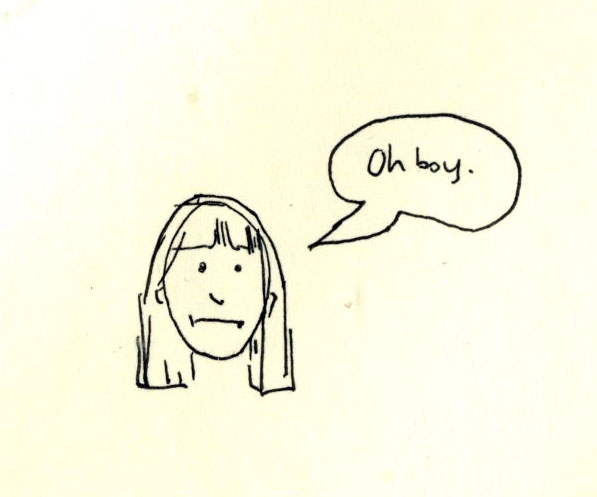

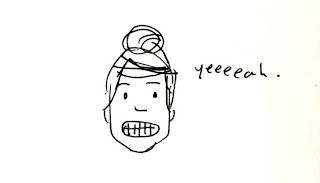


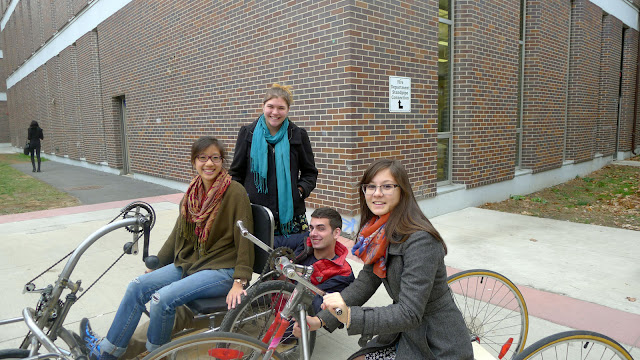

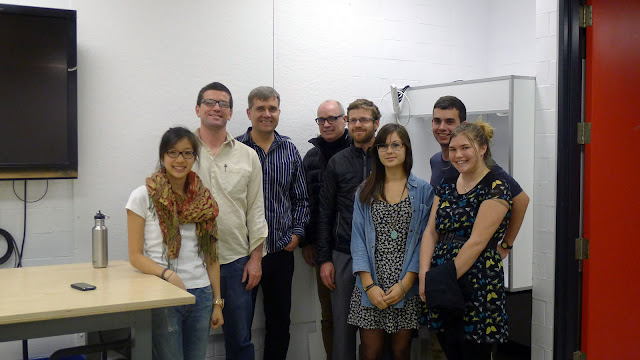





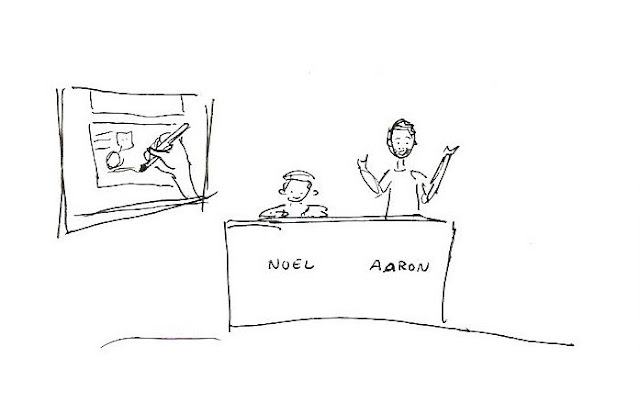

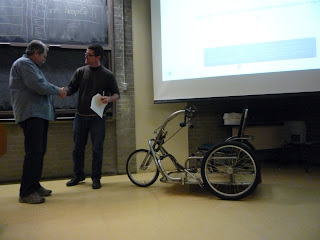



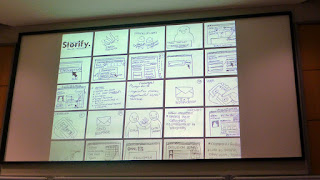


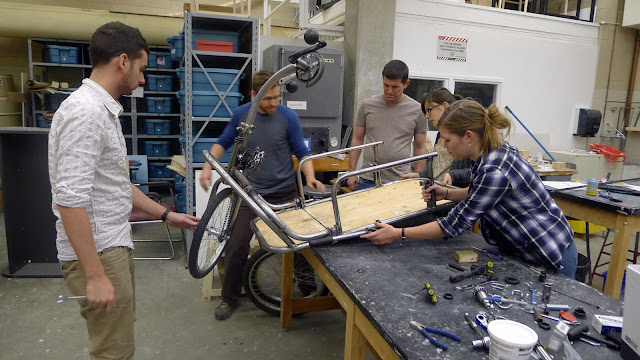


.jpg)

